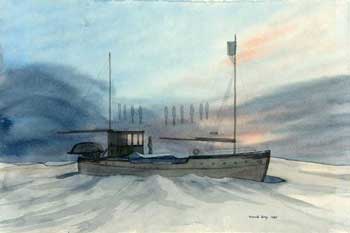Herschel Island at Last
In the late winter the geographers/geologists Cox, Chipman,
and O'Neil, followed the Arctic coast by dog team, east from the international
boundary, up the Firth River, and throughout the east and west channels of the
Mackenzie River Delta, mapping contour lines and geological formations.
It was not until early July that Alaska was again floating
free in the harbour. Alaska left Collinson Point on July 25 and finally
reached Herschel Island ten days later, just ahead of the Mary Sachs. These
expedition vessels were the first to come into Canadian waters in the western
Arctic flying the Canadian flag. At Herschel Island supplies brought in by whaler
were loaded on board. Sailing east again from Herschel Island in ice-free summer
seas, Alaska reached her destination at Bernard Harbour, one of the few
good harbours on the coast. This would be the Expedition's headquarters for the
next two years. Mary Sachs went on to Banks Island in support of the Northern
Party.
The members of the scientific staff, with their Inuit assistants,
unloaded the Alaska and began to construct their winter quarters.
Dr. Anderson started back west with Alaska right away, hoping to collect
driftwood for fuel, as well as more coal cached at the Baillie Islands, before
winter ice set in. Finding weather conditions very favourable at Baillie Islands,
and no ice reported to the west, Anderson continued on back to Herschel Island,
to pick up additional supplies. Alaska left Herschel Island for Bernard
Harbour in mid-September, and arrived back at Baillie Islands in the midst of
a rising gale, heavy snowstorm, and spray freezing on the decks and rigging.
The storm, the worst of the season, delayed them long enough
that Anderson was facing the possibility of being caught by winter before reaching
the safety of Bernard Harbour. So he decided to put the ship into winter quarters
behind the sandspit "As the nights are very dark now, with the moon gone
and more or less ice floating in, it is a precarious matter to sail at night now,
and as young ice is forming pretty thick and slushy at times now, decided to stay
here" (RMA Diary, September 1914).
There were enough supplies on the Alaska for Captain
Daniel Sweeney, who had joined as master the previous winter; Daniel Blue, engineer;
and Mike Siberia, their assistant, to remain as ship-keepers during the winter.
Two fresh whale carcasses on the beach, possibly those killed by the whaling schooner
Polar Bear, near the ship provided an abundance of dog food and also attracted
a number of polar bears and many Arctic foxes to the vicinity.
During the winter, following Anderson's departure by dog team
to Bernard Harbour, the ship-keepers hunted seals and polar bears, retaining the
skins for museum specimens and the meat to augment their food supply. Christmas,
1914 on the Alaska was a quiet one, with the major event – the "big
feed" – being attended by the crew and fourteen Inuit. On December 31, Alaska's
winter crew went out on deck at midnight to see the New Year in, according to
the ancient custom. And so ended the second year of the Canadian Arctic Expedition.
 |
|
CGS Alaska in Winter 1914
original watercolour by David Gray, 1987.
Source: Canadian Museum of Nature
|
|
 |